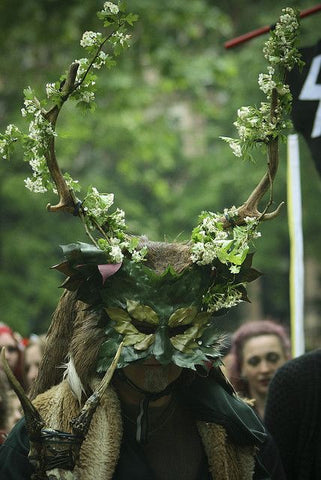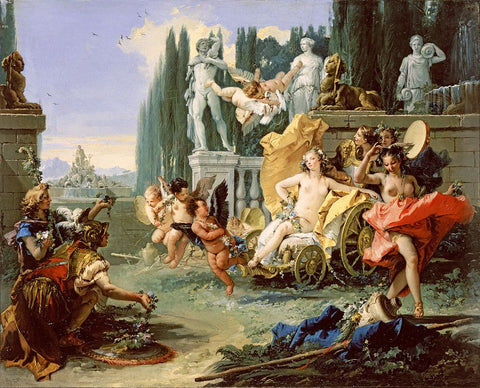April 26, 2024 0 Comments

Ahhh- the enchanting realm of May Day! A time when flowers bloom in riotous colors, the air vibrates with flickers of summer, ancient traditions stir beneath the surface of the earth, and the promise of new beginnings pulsates around us.
From April 28 through May 8, we stand on the threshold between spring's awakening and summer's embrace, Beltane, the spirited celebration also known as May Day. Lets embark on a journey through time to uncover the ancient origins and cultural tapestry of Beltane, from the blazing bonfires of the Celts to the floral splendor of English Flora Day, this magical time of year has a beautifully rich history and diverse multitude of ancient traditions.
Beltane: The Irish Celtic Fire Festival
Before May blossoms into full bloom, the ancient Celts ignited the flames of Beltane, one of the four annual pagan fire festivals which mark the halfway point between an equinox and solstice. In ancient times, the celebration of Beltane was often aligned with the full moon, but the astrological date of Beltane occurs at 15 degrees Taurus- when the sun is precisely in between the Spring Equinox (Ostara) and Summer Solstice (Litha).
Beltane, derived from the Gaelic word "belteine" which means “bright fire”, is a time of joyous revelry and rituals honoring the balance of feminine and masculine energies and the fertility of land and livestock. At this time, special ceremonial fires would be lit, where participants would jump over the flames for cleansing, luck, abundance, fertility, and to find a mate. With bonfires ablaze and dancers weaving intricate, vibrant patterns around Maypoles, this celebration reveres the union of the god Belenus, for healing and protection, and the goddess Belisama, the goddess of fire and sun, heralding the warmth and vitality of summer.

May Day: A Tapestry of Global Traditions
Across distant lands and diverse cultures, the spirit of Beltane weaves its magic into the fabric of May Day celebrations, each culture adding its unique hue to the vibrant tapestry. In Germanic folklore, May Day pays homage to Ostara or Eostre, the goddess of fertility and dawn, whose symbols of eggs and hares later became intertwined with Easter traditions. The Green Man, revered in various European folk traditions, emerges as a masculine symbol of renewal and the cycle of life, celebrated amidst the burgeoning greenery of spring.

Flora Day: English Revelry in Cornwall
In the picturesque town of Helston, Cornwall, England, May Day unfolds in a riot of colors and pageantry during Flora Day, a celebration that blends ancient Celtic customs with Christian influences. Locals adorned in elaborate floral attire take to the streets in joyous processions, accompanied by music and dance, to welcome the arrival of spring's splendor. While Flora Day may have Christianized aspects, its roots trace back to pre-Christian fertility rites, interwoven with Christian observances such as the Feast of St. Michael.
Walpurgis Night: A Germanic Witches' Sabbath
As twilight descends on April 30th, Germanic cultures cast their gaze towards the mystical Brocken, where Walpurgisnacht unfolds in a haze of folklore and superstition.
Named after Saint Walpurga, this night is believed to be when witches gather atop the Brocken for revelry and mischief, amidst bonfires lit to ward off malevolent spirits. Despite its Christian veneer, Walpurgisnacht echoes the ancient pagan customs of Beltane, where the veil between worlds thins, and magic stirs in the shadows. Being that this time of year is opposite the fire festival of Samhain (modern day Halloween on the wheel of the year), it's clear that Walpurgisnacht can be considered the spring version of Samhain or Hallow’s Eve!

The wheel of the Year, from medium.com
Floralia: Ancient Rome Celebrations Floralia and Rosalia
Amidst the ancient Roman Empire, Floralia emerged as a vibrant festival honoring Flora, the Roman goddess of flowers and fertility, whose essence permeated the lush landscapes of spring. Taking place from April 28th to May 3rd, Floralia was a time of jubilant festivities, marked by floral adornments, theatrical performances, and lavish banquets. Floralia celebrated the bountiful blessings of nature's renewal, with revelers indulging in playful games and dances, evoking the joy and vitality of the season. Likewise, another Roman holiday called Rosalia, celebrated flowers, particularly roses and violets, during the month of May. Rosalia celebrations were considered a commemoration of the dead, where it was customary to place flowers at burial sites.
Both holidays of Roman roots reflect a deep reverence for the transformative power of nature and the eternal cycle of life's renewal, paralleling other springtime celebrations as well as its relationship to Samhain
International Labor Day: A Modern Evolution
While distinct from the ancient rituals of Beltane, Labor Day stands as a modern incarnation of collective action and communal celebration, honoring the resilience and spirit of the human endeavor. In the bustling streets of cities worldwide, May 1st takes on a new guise as International Workers' Day or Labor Day, embodying the spirit of solidarity and social justice.
Stemming from the labor movement of the late 19th century, Labor Day champions the rights and dignity of workers, a testament to the enduring quest for fairness, equality, and work-life balance. Additionally, for those of us in the U.S., we also honor Black Women’s Labor Day on April 5th, celebrating the brilliance and legacy of Black Women and femmes in the Labor Movement. Honoring the continued intuition and energy that feminine figures bring to society only magnifies the sacred archetype of growth and fertility of the season.

As we stand at the intersection of Spring and Summer, let us embrace the timeless magic and vibrant traditions that animate this spirited season on May Day. Whether dancing around the Maypole while cooking up special soups in a cauldron, weaving floral garlands, or kindling bonfires, May Day beckons us to rejoice in the eternal rhythms of nature and the boundless spirit of renewal that courses through the world around us.
Here's a simple ritual you can partake in on Beltane and May Day celebrations, utilizing our Growth & Fertility Ritual Kit:
You Will Need:
Simple Steps
Read more on astrology, horoscopes, occultism, magick & ritual on our blog, Esoteric Insights!
February 25, 2025 0 Comments
As we navigate the celestial currents of 2025, a unique astrological event awaits: both Venus and Mercury will be retrograde simultaneously. Venus will transition from Aries to Pisces during its retrograde, while Mercury will retrograde in Aries. This rare cosmic alignment offers a profound opportunity for introspection, reassessment, and personal growth. When these two influential planets appear to move backward in the sky, their retrograde energies prompt us to slow down and reevaluate critical aspects of our lives. While the experience may seem challenging, it ultimately serves as a chance to heal, reset, and reconnect with our true desires and intentions.
February 12, 2025 0 Comments
Throughout history, the name Cupid, or Eros, has been synonymous with romance, desire, and playful mischief. This cherubic archer, often depicted as a winged boy with a bow and quiver full of arrows, has roots far deeper than modern Valentine’s Day iconography. Originating in ancient mythology, Cupid’s story intertwines love and fate, often with dramatic and unexpected consequences. But who exactly is Cupid, and what is the lore behind this mischievous god of love?
December 17, 2024 0 Comments